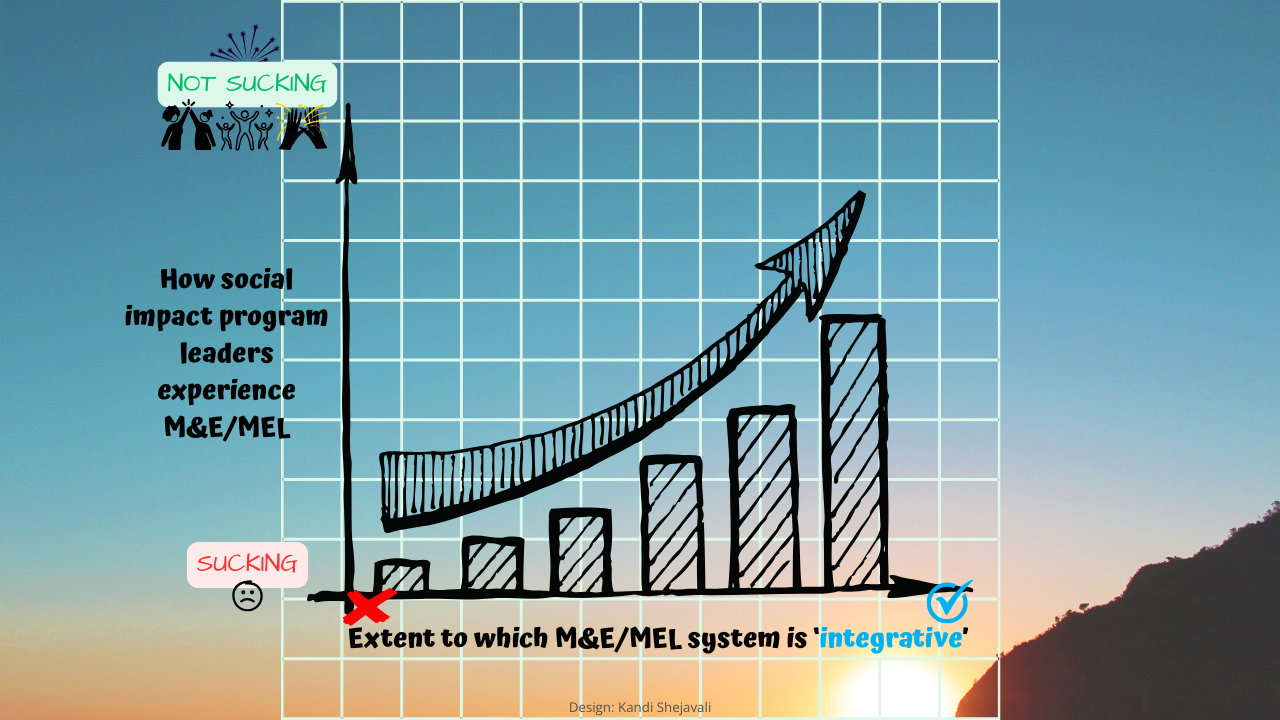A mindset of service: M&E systems that win accolades from program management teams
Apr 25, 2022
Monitoring and evaluation (M&E) specialists often lament that the rest of the program team doesn’t appreciate M&E work.
What evidence do they cite for leveling this charge?
And assuming that M&E specialists are right about the lack of appreciation, might they themselves be to blame – at least partially?
More importantly, what concrete steps can be taken to win ‘non-M&E’ program team members over – even win their accolades – when it comes to M&E?
Let’s discuss!
[RELATED RESOURCE: If you’re not sure why project teams should appreciate M&E in the first place, download the Basics of M&E: A cheat sheet for beginners or read this article that includes a description of the purpose that M&E serves.]
Innocent until proven guilty (or what is the justification for this accusation?)
M&E specialists cite numerous examples as evidence of the lack of appreciation for their work.
They note, for example, that program leadership doesn’t make the necessary financial resources available for M&E activities; yet program leaders expect the M&E function to produce results.
As further evidence of the lack of appreciation for their work, M&E specialists cite the reluctance of program management – and sometimes even of funders – to capture the lessons learned from program implementation and translate them into follow-on programming.
Furthermore, the lament of M&E team members goes, program teams often see M&E as a tick-box exercise. That is, as “[an] activity…performed perfunctorily and with resignation, more to serve a bureaucratic expediency than to accomplish any higher purpose” (The Free Dictionary 2011).
- In the context of M&E for international development projects, the ‘bureaucracy’ being served is typically the project’s overseas donor(s).
- Similarly, community development programs and nonprofits seek to ensure that their funders’ ‘boxes’ for M&E are ‘ticked’ off as having been done and dusted, so that they can move on with the ‘real’ work.
- In both these and other contexts, the ‘box-ticking’ is typically mostly concerned with meeting reporting requirements.
The sentiment underlying the complaint of M&E specialists is that once those requirements have been met at the surface level, like a burden to be quickly shrugged off, the program team carries on without recognizing the utility of M&E for steering purposes.
To add insult to injury, according to M&E specialists the M&E function even gets blamed for poor program results (apparently because the M&E function is the one that uncovered them?) or accused of serving an overly intrusive investigative function.
And the list goes on….
Um, maybe look in the mirror first, M&E Specialist?
I get what M&E specialists are saying – I’ve been there. “I’ve even worked on projects where [non-M&E] colleagues felt that M&E got in the way of implementation” (Shejavali 2021a).
But do we as M&E specialists need to share at least some of the blame for the lack of appreciation of our work?
Yes indeedy, I’d say.
I’ve come across M&E systems with vastly over-articulated theories of change, lists of indicators as long as Mount Everest is high (allow me a wee bit of exaggeration, okay?), a spider’s web of components that even Charlotte would get lost in, and all manner of bells and whistles that make the system look sophisticated but entirely unapproachable.
All of it created by one M&E specialist or another.
We simply do not do enough to make our M&E systems practical for program management purposes all while meeting the various standards of the profession and aligning with donors’ M&E requirements.
So, like Michael Jackson suggests in one of his innumerable hits, let’s start “with the [person] in the mirror… [taking a look at ourselves, then making a change]” (Ballard 1988).
Changing M&E ways for the better
The biggest change M&E specialists can make to engender appreciation has to do with mindset. No, not the program management team’s mindset, my dear M&E specialists. It has to do with how you, the M&E-er, view M&E vis-à-vis the program’s sector activities. Specifically, it has to do with viewing M&E as being in service to the program.
Sure, M&E practitioners understand that the M&E system exists to monitor, evaluate, and maximize the results of the program. In that sense, they’re already aware that M&E exists to serve the program.
But when it comes down to the practical details, this service orientation often disappears somewhere along the way and M&E reverts to habits that justified how it’s traditionally viewed, namely “as a bean-counting – almost auditing – activity, concerned mostly with making demands for data, compiling numbers, and creating endless indicator tables, charts, graphs, and reports… directed at complying with the demands of far-removed donors” (Shejavali 2021b).
Instead, truly being in service implies that M&E practitioners view the rest of the program team as an internal client, with the M&E role being to serve that client in a way that makes their interaction with the M&E system as user-friendly and beneficial as possible.
In practical terms, this means setting the M&E system up to be inclusive, straightforward, coherent, and as seamlessly integrated with ongoing project operations as possible. Such an approach involves a co-creation of the M&E approach, including with regard to the M&E system’s objectives and principles.
[RELATED RESOURCE: For a guide on how to set up such a system, download my free 3 no-hassle steps towards a practical and effective M&E system. The pdf guide is available via the TolaData site here (just look for the word “gift” in the first paragraph).]
Being of true service to the program also implies being transparent about where the various M&E processes and tools fit in the overarching framework.
This helps make every touchpoint that internal and external stakeholders have with the M&E system one that fits into an intelligible framework and that ultimately serves the management team’s program steering and adaptation-for-improvement needs.
M&E practitioners who take this approach help orient the profession towards “serving as a management tool for project decision-makers rather than being a checkbox exercise that projects only comply with in order to keep the money rolling in” (TolaData 2022).
And that translates to winning appreciation – if not accolades – from management and from the program team at large.
Conclusion
Now I’m not saying that this will win M&E fans overnight. (Sigh, if only it were that easy.)
But if M&E specialists adopt a service mindset and apply everything that goes along with such a mindset – and add to that a patient willingness to demonstrate M&E’s utility on an ongoing basis –, I can just about guarantee that the rest of the program team’s appreciation for M&E will increase many times over.
Over to you!
PRACTICAL TIP #1: Time to do some self-examination. Interrogate the mindset underlying the M&E that you (if you’re an M&E specialist) do for the program you work on. Is it coming from a place of true service to the program?
PRACTICAL TIP #2: Analyze the elements of the program’s M&E system from a service angle. What could be done to make more of the touchpoints that the other program team members have with the M&E system more inclusive, straightforward, coherent, and seamlessly integrated with ongoing operations? If you need help, you can draw from the steps outlined in the downloadable 3 no-hassle steps towards a practical and effective M&E system guide, which is available via the TolaData site here (just look for the word “gift” in the first paragraph).
PRACTICAL TIP #3: Commit to taking at least one of the steps you identified in PRACTICAL TIP #2 within the coming week.
Update of 5 May 2022: Please share your experience by commenting or leaving an emoticon reaction at the bottom of this LinkedIn post.
Update of 9 September 2025: Article updated to correct typos and make other non-substantive improvements.
References:
Ballard, G. and Garrett, S. (1988). Michael Jackson: The man in the mirror. Epic Records. Official music video available at: https://www.youtube.com/watch?v=PivWY9wn5ps (accessed: 4 April 2022).
Shejavali, K. (2021a, March 12). Rethinking M&E. What is it to you? LinkedIn Pulse. Available at: https://www.linkedin.com/pulse/rethinking-me-what-you-kandi-shejavali (accessed: 4 April 2022).
The Free Dictionary (2011) “tick box exercise”. Web page. Segen's Medical Dictionary, Farlex, Inc. Available at: https://medical-dictionary.thefreedictionary.com/tick+box+exercise (accessed: 4 April 2022).
TolaData (2022, January 26). Widen your M&E horizon w/ specialist Kandi Shejavali - Part 2. Interview. TolaData. Available at: https://www.toladata.com/blog/widen-your-m-and-e-horizon-with-specialist-kandi-shejavali-part-2/ (accessed: 4 April 2022).
Photo credit:
Anthony Delanoix on Unsplash
Suggestion for how to cite this article (using APA 7 style):
Shejavali, K. (2022, April 25). A mindset of service: M&E systems that win accolades from project management teams. Blog post. RM3 Consulting. Available at: https://rm3resources.com/blog/mindset-of-service-me-systems-that-win-accolades (accessed: [insert the date that you last accessed this article at the provided link]).





